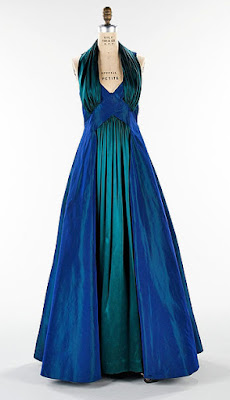Elizabeth Hawes is probably the best American designer you never heard of. That's not to say no one has heard of her. I found plenty of information doing research for this blog. Almost every entry begins "Elizabeth Hawes, the best American designer you never heard of".
Elizabeth Hawes' designs, though, are not the reason to read "Fashion is Spinach". She doesn't promote herself. There are no photos of her work, hence the research. Written in 1938, at the height of her career as one of a handful of American couturiers and (somewhat reluctant) designer of popular-priced apparel, "Fashion is Spinach" is written as both a memoir of her early days sketching and designing in Paris—she had moxie—and a diatribe against the American fashion industry.
 |
| Elizabeth Hawes in 1938, age 35 |
Much has changed since the 1930s, but "Fashion is Spinach" helps to explain how we got to the fashion state we are in now—a general sense of dissatisfaction from not enough dependable retail, too many choices but nothing to love, poor quality fabric/workmanship and the unsettling feeling we still don't know what to wear.
That doesn't sound like a jolly read, but while Hawes pulls no punches, she is smart and funny, opinionated but not obnoxious. She reveals some hard truths about the business of fashion—how it's designed, manufactured and promoted. We, the customers, don't stand a chance.
About that title: "I say it's spinach" was a New Yorker cartoon from 1928, drawn by Carl Rose and captioned by E. B. White. It hit all the right notes and has been used and referred to in many ways over time, even in song lyrics. Elizabeth Hawes wrote for the New Yorker about this time (dispatches from Paris), so she surely knew it.
Right from the beginning Hawes declares that Fashion is not worth much; it's Style that matters. We tend to confuse the two, with "in style" meaning the same as "in fashion". Hawes feels they are very different. We should seek Style and not be manipulated by Fashion. Style didn't pay her bills, though, and she walked a tightrope between commerce and couture. Designing for the masses (manufactured goods) essentially kept the couture business afloat.
In "Spinach" Hawes believes that America would in time establish a system of couture like Paris—one-off beautiful clothing made to exacting standards and perfectly fitted on clients who could afford the time and money. In 1938 America was coming out of the Depression and not expecting another world war around the corner. WWII changed everything. With wartime shortages and no Paris couture to copy, American design found its true voice, but not in the way she imagined.
What about her own designs? She complained bitterly that anything she designed for the mass market was poorly made, so we can assume those examples have not survived. Her couture customers had to come to her townhouse/studio on East 67 Street in New York City. She railed against the stiff and uncomfortable get-ups men were forced to wear in the evening but felt women could look their most alluring and be the most comfortable in evening wear. She hated gew-gaws and trim, even belts, but she was a master of intricate cutting and piecing, oddball color combos and always chose beautiful fabrics. A few beauties follow, but please don't make me choose my favorite:









I've never heard of Hawes, thanks, Michelle! These designs are amazing, and could be worn today - it only proves that "fashion is fleeting, but style is forever"!
ReplyDeleteThat's exactly what she was getting at! I hope you have a chance to read it. I should have mentioned that Dover Books did a reprint a few years ago. You might even find it in your library.
Deletei want every one of those dresses!!!!!!!!!!!!!!!! it may be spinach but it is GOOD!!!
ReplyDeleteThis is not spinach; it's Style! ; > )
DeleteAmazon has a Kindle edition for only $3.76. I also found it in my library's Hoopla catalog..
ReplyDeleteThe above dresses are stunningly beautiful.
Thanks for the info; I hope you enjoy it!
Delete